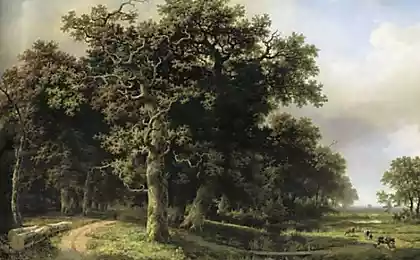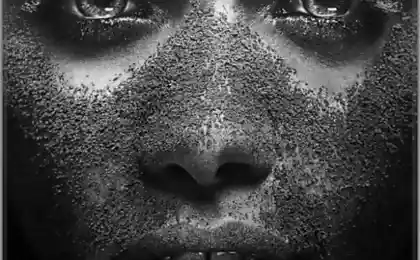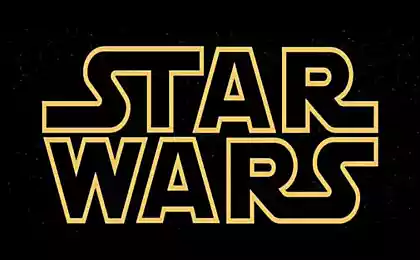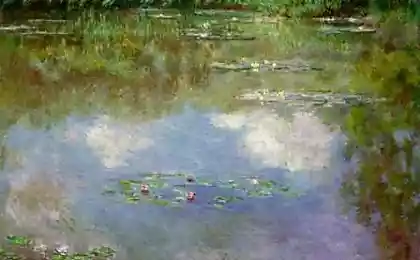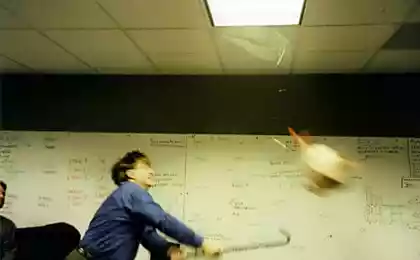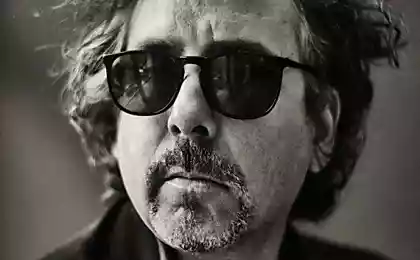737
15 paintings where the artist painted life as we would like to see it
Sixty million seven hundred thirty nine thousand two hundred twenty one
Norman Rockwell is an iconic painter of the twentieth century, illustrations of which grew up not one generation of children. He's not just drawing, he was telling stories and always portrayed characters with unusual warmth and sympathy, seasoning picture a good sense of humor.
The website has collected 20 paintings which the master told the world stories of everyday life in great detail.
The runaway, 1958
In his paintings, Rockwell portrayed a perfect version of the world, filled with kindness and warmth. Usually the scene where the children run away from home, should be cause for concern and anxiety. But not here — the little fugitive, trapped in a bar surrounded with care and protected. The boy seemed guarded in the middle of the triangle to the left in a fatherly way to him, bent COP, in the center of good-natured smiles at the bartender, and on the right, judging by the empty coffee Cup, not so long ago were a guy. Any artist in the world no child is in danger, and for police, there is no more serious business than it is to talk with the young fugitive and convince him to return home.
Cleansize Rosie, 1943
In the United States during the Second world war began, a national campaign to encourage women who have never worked before, to join the ranks of the workers. They mastered a completely new area of work, taking the traditional place of men who went to the front. Painting Rockwell shows clearly that the labor for women, even on the factory or plant, does not require to abandon femininity. Rosie, which we see in the picture, determined to contribute to the victory in the war. That's what made "Cleansize Rosie" is a cultural icon of the United States.
The problem with which we all live, 1964
A vivid illustration of the formation of racial equality in America in the 60's. character in the picture is 6-year-old African-American girl ruby bridges, one of the first black students were allowed to study in the "white" school, is escorted by members of the U.S. marshals. Behind the visible inscription "KKK" offensive "nigger" and the trail of tomato thrown in ruby.
Drinking prayer, 1951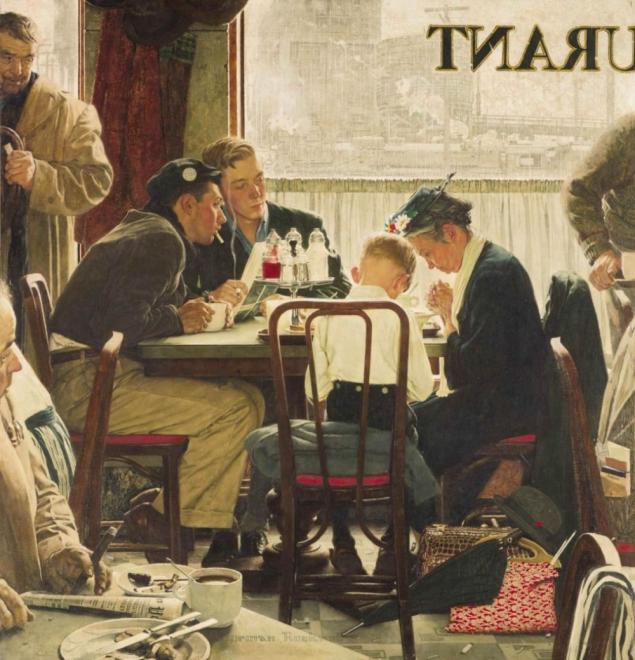
This work is imbued with the spirit of postwar America. This illustration the artist wanted to answer many questions Americans: how, through violence and cruelty, to keep faith in the goodness and where to get the strength to face the future with hope? The idea of the story appeared thanks to one of the readers: her eyes in the cafe ran into a woman with a small naughty boy and had no qualms overcrowded hall, for a few moments they stood in prayer. Impressed with the story, Rockwell wrote that scene so realistically, as if he saw her.
This work became the most expensive work of American realist art — in 2013 it was sold for $ 46 million.
Moving out of his home, 1954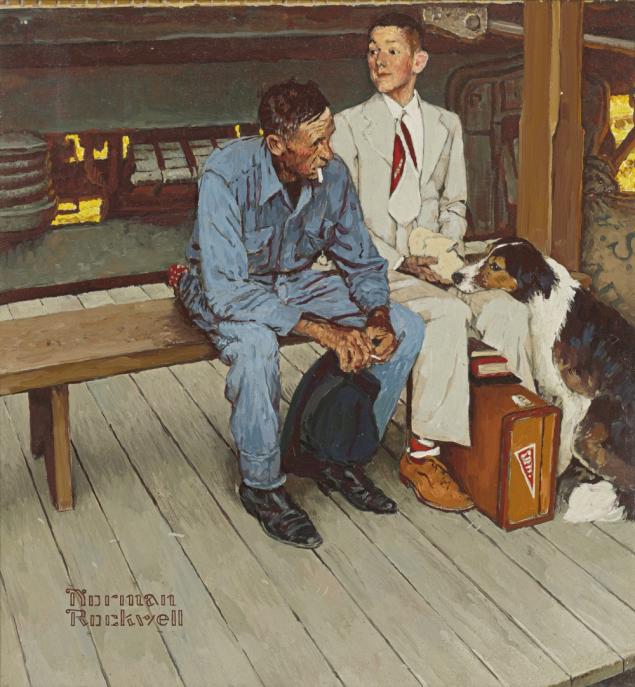
"I wanted to Express what a father feels when his children leave the house," said Rockwell about this illustration. Father and son sitting on a bench waiting for the train to take son to College. Son is enthusiastically awaiting the arrival of the train which will take him to a new, adult life. The opposite feeling of experiencing the father — he visibly wilted, gripping an unlit cigarette and his hat in his hands. Father is nothing left to do except wait for the inevitable arrival of the train to take his son far away from home.
Girl with black eye 1953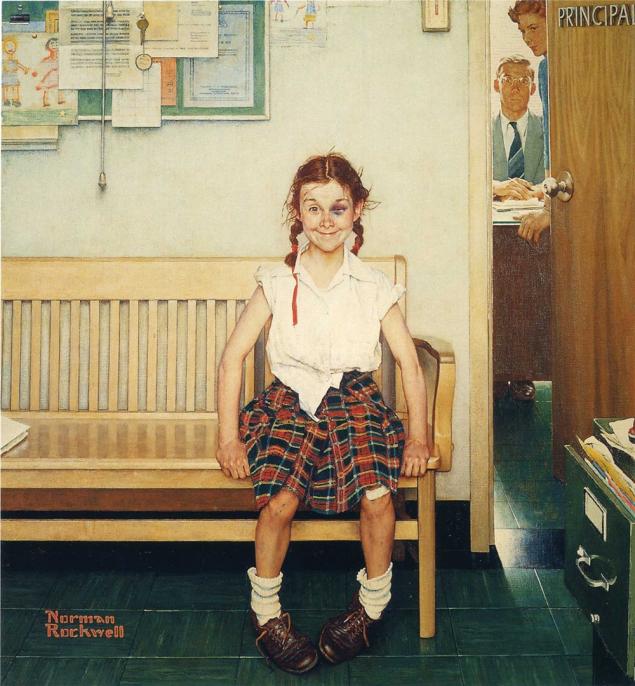
Of joyful girl's face, we can confidently say that she left the fight winner. Now she is waiting for a call to the school Director. It is hardly possible to determine how the fight started and who was its initiator, who was defeated, but one thing is clear: the other guy looks much worse than it is. Look at the woman's face that was peeking out from the Cabinet with sympathy, — this is probably her teacher.
On election day, 1948
November 2, 1948 — election day of the President of the United States. The main contenders — Harry Truman and the famous Governor of new York Thomas Dewey. Nobody believed that a Democrat Truman can win bright and the beloved Republican Dewey. The wife in the picture, an ordinary American who wants a simple and clear to her Truman. And my husband believes that smart Dewey is exactly what the country needs. When election night ended, it became clear that Truman defeated Dewey. When the shock had passed, analysts have determined that for Truman voted ordinary Americans — workers, clerks and small shopkeepers.
Salesgirl on Christmas eve, 1947
Paintings Rockwell — these mini-stories about daily life. Sometimes even the feeling that the illustrations literally copied from our lives. If you look closely, the hands on the clock saleswomen show 17:05 — sure, she is happy that this day finally came to an end.
A marriage license, 1955
A sign on the door "Permission for marriage" begins to tell this story. This scene is full of contrasts, like many of the artist's paintings. Bright daylight shining through the window illuminates the dark old room. Compare how concentrated a young couple and some seem superfluous here bored elderly clerk. God knows how much evidence he gave in this shabby room. However, the clerk here at ease — close to his cat, heater and blooming geraniums in the window, which he clearly cares. The calendar on the wall shows date of marriage — June 11, 1955.
Scout came to the rescue, 1941
Norman Rockwell didn't just paint American life. He preached universal values, he built hope and faith in the national idea, after all, the smile and kindness saved in the difficult times of war, and solidarity and decency came to the fore. He said: "In my paintings there is no place for dirt and ugliness. I paint life the way I wanted her to see."
Good friends, 1927
The artist invites us to see a touching world of children, a real joy and spontaneity. Light and bright painting of Norman Rockwell's warm and reminiscent of the main values of our life.
Soda, 1953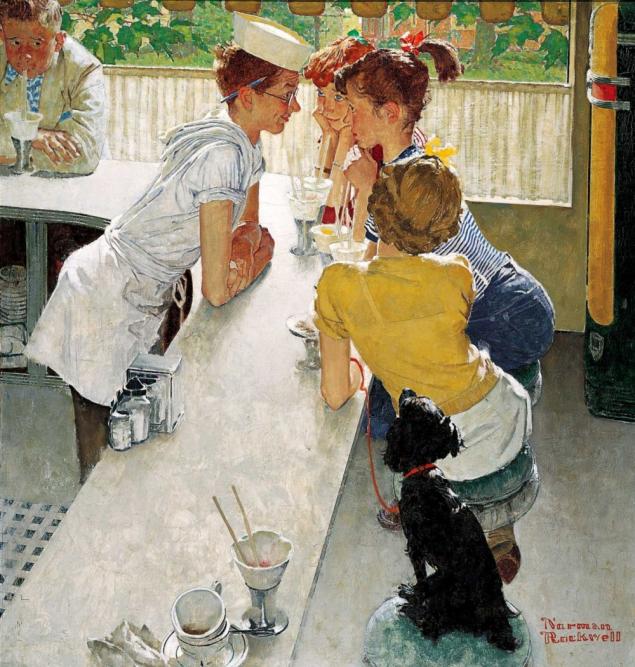
This idea Rockwell took from the stories of his son, who worked in a summer cafe. The young lady liked to go to cafes, it's not for soda and ice cream. Chubby guy in the corner of the painting looks at the seller and his fans hurt: "What has he (except ice cream), I don't have?" It is charming good-naturedness, typical of Rockwell's paintings, complemented by the detail to which the artist belonged especially sensitive: wooden floor behind the counter, clean dishes on the counter or the reflection of the chrome sugar bowl in the bowl.
The four freedoms: Freedom of speech, 1943
The most famous work of Rockwell's series of paintings "the Four freedoms", inspired by Roosevelt's speech on the rights that we now take for granted. The plot for "freedom of speech" went to the real case: "I suddenly remembered how Jim Edgerton had stood up at a town meeting and said something that did not like all those present on it. But he was given the opportunity to speak. No one told him to shut up. "Oh my God, I thought. — Here it is. Freedom of speech"".
The four freedoms: Freedom of worship, 1943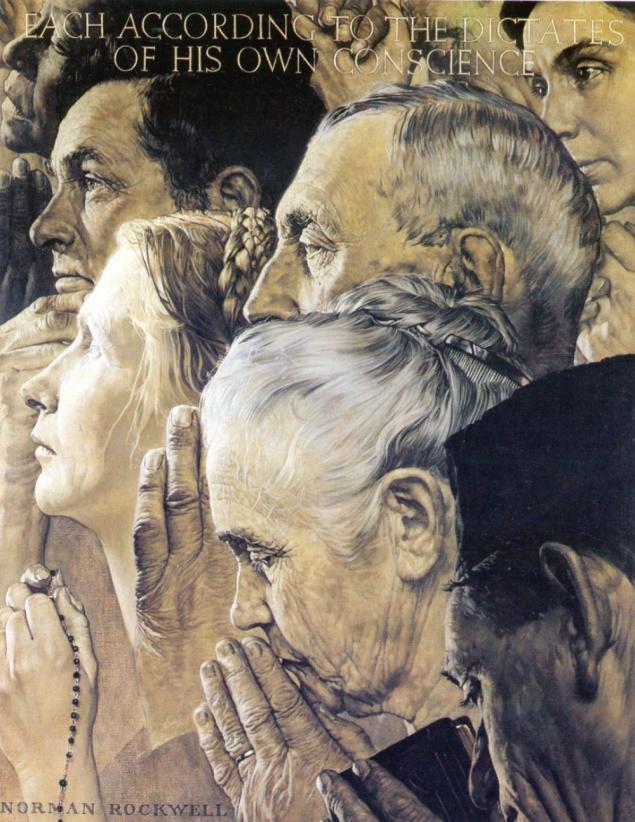
In this work have a much deeper meaning than it seems at first glance. 8 profiles show that people of different faiths: Protestant, Catholic woman with a rosary, man with a Jewish yarmulke, and an African-American woman in the top left corner. Soft Golden light that fills the painting, almost monochromatic and performance reflect how different, but at the same time as similar heroes of this picture.
The four freedoms. Freedom from fear, 1943
His paintings can even in the darkest times to light the hearts of people. "Freedom from fear" became one of the iconic films of the postwar period — a warm and peaceful evening, when parents tuck their children. Rockwell expressed the freedom from fear, inspired by Roosevelt's speech on "world-wide reduction of armaments to such a degree that no nation will be in a position to commit an act of physical aggression against their neighbors and any other countries."
The four freedoms: Freedom from want, 1943
"When I grew up and discovered that the world is not such a pleasant place as I thought, I unconsciously decided that, even if it's not a perfect world, it needs to be painted of me is in my paintings, which will not be drunken vagrants or evil mothers, on the contrary, only good parents and happy children," said Norman Rockwell.
Christmas meeting, 1948
One of the most famous works of the artist — about Christmas. To make this painting truly alive, he depicted his own family — we can see it on the right side with a constant pipe in his mouth. In the center — his adult son who has come home for the Christmas holidays in the strong maternal arms, because communication with children and grandchildren — the main joy for elderly parents.
Photo preview of the Norman Rockwell
via www.nrm.org/
Norman Rockwell is an iconic painter of the twentieth century, illustrations of which grew up not one generation of children. He's not just drawing, he was telling stories and always portrayed characters with unusual warmth and sympathy, seasoning picture a good sense of humor.
The website has collected 20 paintings which the master told the world stories of everyday life in great detail.
The runaway, 1958

In his paintings, Rockwell portrayed a perfect version of the world, filled with kindness and warmth. Usually the scene where the children run away from home, should be cause for concern and anxiety. But not here — the little fugitive, trapped in a bar surrounded with care and protected. The boy seemed guarded in the middle of the triangle to the left in a fatherly way to him, bent COP, in the center of good-natured smiles at the bartender, and on the right, judging by the empty coffee Cup, not so long ago were a guy. Any artist in the world no child is in danger, and for police, there is no more serious business than it is to talk with the young fugitive and convince him to return home.
Cleansize Rosie, 1943

In the United States during the Second world war began, a national campaign to encourage women who have never worked before, to join the ranks of the workers. They mastered a completely new area of work, taking the traditional place of men who went to the front. Painting Rockwell shows clearly that the labor for women, even on the factory or plant, does not require to abandon femininity. Rosie, which we see in the picture, determined to contribute to the victory in the war. That's what made "Cleansize Rosie" is a cultural icon of the United States.
The problem with which we all live, 1964

A vivid illustration of the formation of racial equality in America in the 60's. character in the picture is 6-year-old African-American girl ruby bridges, one of the first black students were allowed to study in the "white" school, is escorted by members of the U.S. marshals. Behind the visible inscription "KKK" offensive "nigger" and the trail of tomato thrown in ruby.
Drinking prayer, 1951

This work is imbued with the spirit of postwar America. This illustration the artist wanted to answer many questions Americans: how, through violence and cruelty, to keep faith in the goodness and where to get the strength to face the future with hope? The idea of the story appeared thanks to one of the readers: her eyes in the cafe ran into a woman with a small naughty boy and had no qualms overcrowded hall, for a few moments they stood in prayer. Impressed with the story, Rockwell wrote that scene so realistically, as if he saw her.
This work became the most expensive work of American realist art — in 2013 it was sold for $ 46 million.
Moving out of his home, 1954

"I wanted to Express what a father feels when his children leave the house," said Rockwell about this illustration. Father and son sitting on a bench waiting for the train to take son to College. Son is enthusiastically awaiting the arrival of the train which will take him to a new, adult life. The opposite feeling of experiencing the father — he visibly wilted, gripping an unlit cigarette and his hat in his hands. Father is nothing left to do except wait for the inevitable arrival of the train to take his son far away from home.
Girl with black eye 1953

Of joyful girl's face, we can confidently say that she left the fight winner. Now she is waiting for a call to the school Director. It is hardly possible to determine how the fight started and who was its initiator, who was defeated, but one thing is clear: the other guy looks much worse than it is. Look at the woman's face that was peeking out from the Cabinet with sympathy, — this is probably her teacher.
On election day, 1948

November 2, 1948 — election day of the President of the United States. The main contenders — Harry Truman and the famous Governor of new York Thomas Dewey. Nobody believed that a Democrat Truman can win bright and the beloved Republican Dewey. The wife in the picture, an ordinary American who wants a simple and clear to her Truman. And my husband believes that smart Dewey is exactly what the country needs. When election night ended, it became clear that Truman defeated Dewey. When the shock had passed, analysts have determined that for Truman voted ordinary Americans — workers, clerks and small shopkeepers.
Salesgirl on Christmas eve, 1947

Paintings Rockwell — these mini-stories about daily life. Sometimes even the feeling that the illustrations literally copied from our lives. If you look closely, the hands on the clock saleswomen show 17:05 — sure, she is happy that this day finally came to an end.
A marriage license, 1955

A sign on the door "Permission for marriage" begins to tell this story. This scene is full of contrasts, like many of the artist's paintings. Bright daylight shining through the window illuminates the dark old room. Compare how concentrated a young couple and some seem superfluous here bored elderly clerk. God knows how much evidence he gave in this shabby room. However, the clerk here at ease — close to his cat, heater and blooming geraniums in the window, which he clearly cares. The calendar on the wall shows date of marriage — June 11, 1955.
Scout came to the rescue, 1941

Norman Rockwell didn't just paint American life. He preached universal values, he built hope and faith in the national idea, after all, the smile and kindness saved in the difficult times of war, and solidarity and decency came to the fore. He said: "In my paintings there is no place for dirt and ugliness. I paint life the way I wanted her to see."
Good friends, 1927

The artist invites us to see a touching world of children, a real joy and spontaneity. Light and bright painting of Norman Rockwell's warm and reminiscent of the main values of our life.
Soda, 1953

This idea Rockwell took from the stories of his son, who worked in a summer cafe. The young lady liked to go to cafes, it's not for soda and ice cream. Chubby guy in the corner of the painting looks at the seller and his fans hurt: "What has he (except ice cream), I don't have?" It is charming good-naturedness, typical of Rockwell's paintings, complemented by the detail to which the artist belonged especially sensitive: wooden floor behind the counter, clean dishes on the counter or the reflection of the chrome sugar bowl in the bowl.
The four freedoms: Freedom of speech, 1943

The most famous work of Rockwell's series of paintings "the Four freedoms", inspired by Roosevelt's speech on the rights that we now take for granted. The plot for "freedom of speech" went to the real case: "I suddenly remembered how Jim Edgerton had stood up at a town meeting and said something that did not like all those present on it. But he was given the opportunity to speak. No one told him to shut up. "Oh my God, I thought. — Here it is. Freedom of speech"".
The four freedoms: Freedom of worship, 1943

In this work have a much deeper meaning than it seems at first glance. 8 profiles show that people of different faiths: Protestant, Catholic woman with a rosary, man with a Jewish yarmulke, and an African-American woman in the top left corner. Soft Golden light that fills the painting, almost monochromatic and performance reflect how different, but at the same time as similar heroes of this picture.
The four freedoms. Freedom from fear, 1943

His paintings can even in the darkest times to light the hearts of people. "Freedom from fear" became one of the iconic films of the postwar period — a warm and peaceful evening, when parents tuck their children. Rockwell expressed the freedom from fear, inspired by Roosevelt's speech on "world-wide reduction of armaments to such a degree that no nation will be in a position to commit an act of physical aggression against their neighbors and any other countries."
The four freedoms: Freedom from want, 1943

"When I grew up and discovered that the world is not such a pleasant place as I thought, I unconsciously decided that, even if it's not a perfect world, it needs to be painted of me is in my paintings, which will not be drunken vagrants or evil mothers, on the contrary, only good parents and happy children," said Norman Rockwell.
Christmas meeting, 1948

One of the most famous works of the artist — about Christmas. To make this painting truly alive, he depicted his own family — we can see it on the right side with a constant pipe in his mouth. In the center — his adult son who has come home for the Christmas holidays in the strong maternal arms, because communication with children and grandchildren — the main joy for elderly parents.
Photo preview of the Norman Rockwell
via www.nrm.org/
